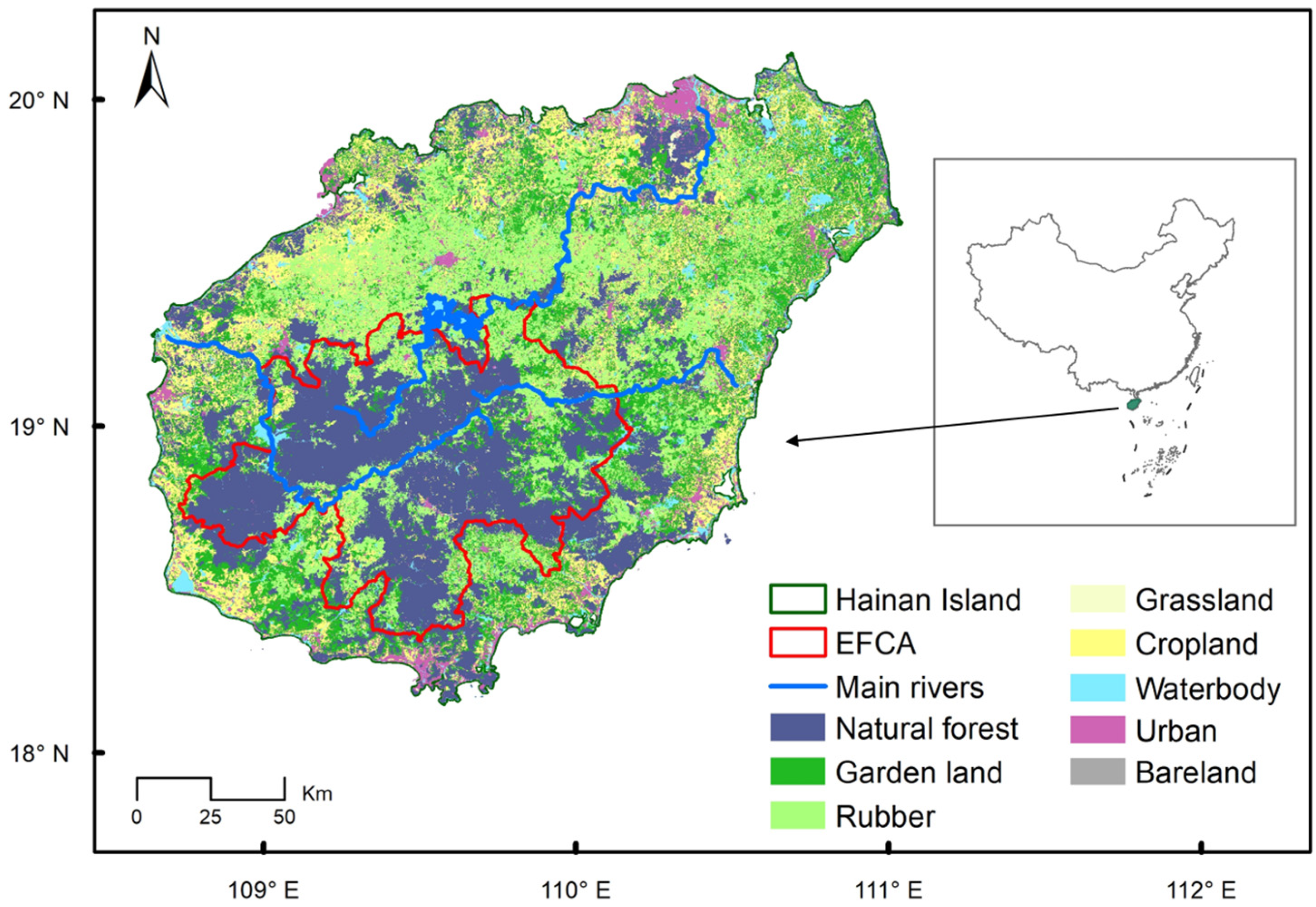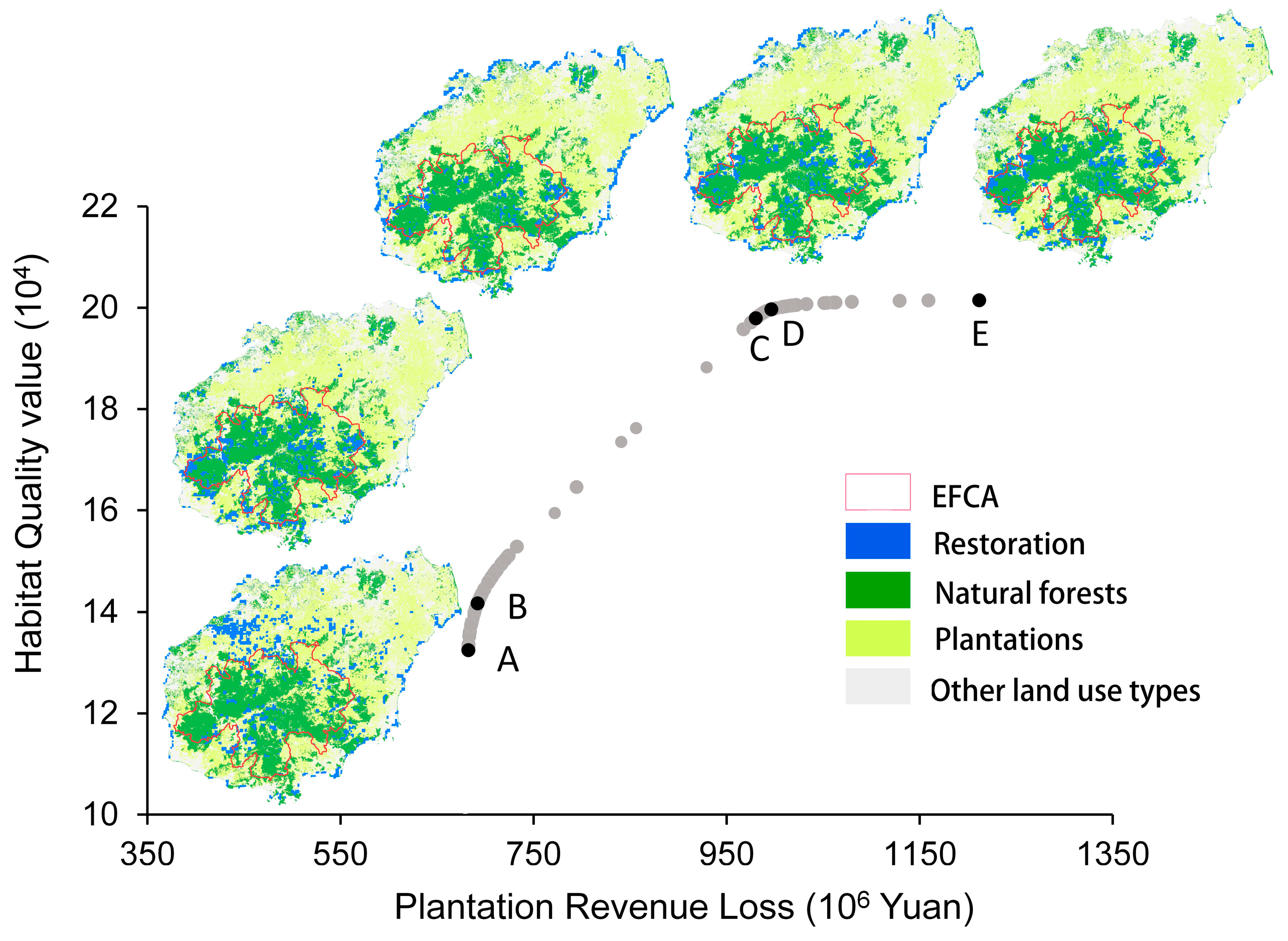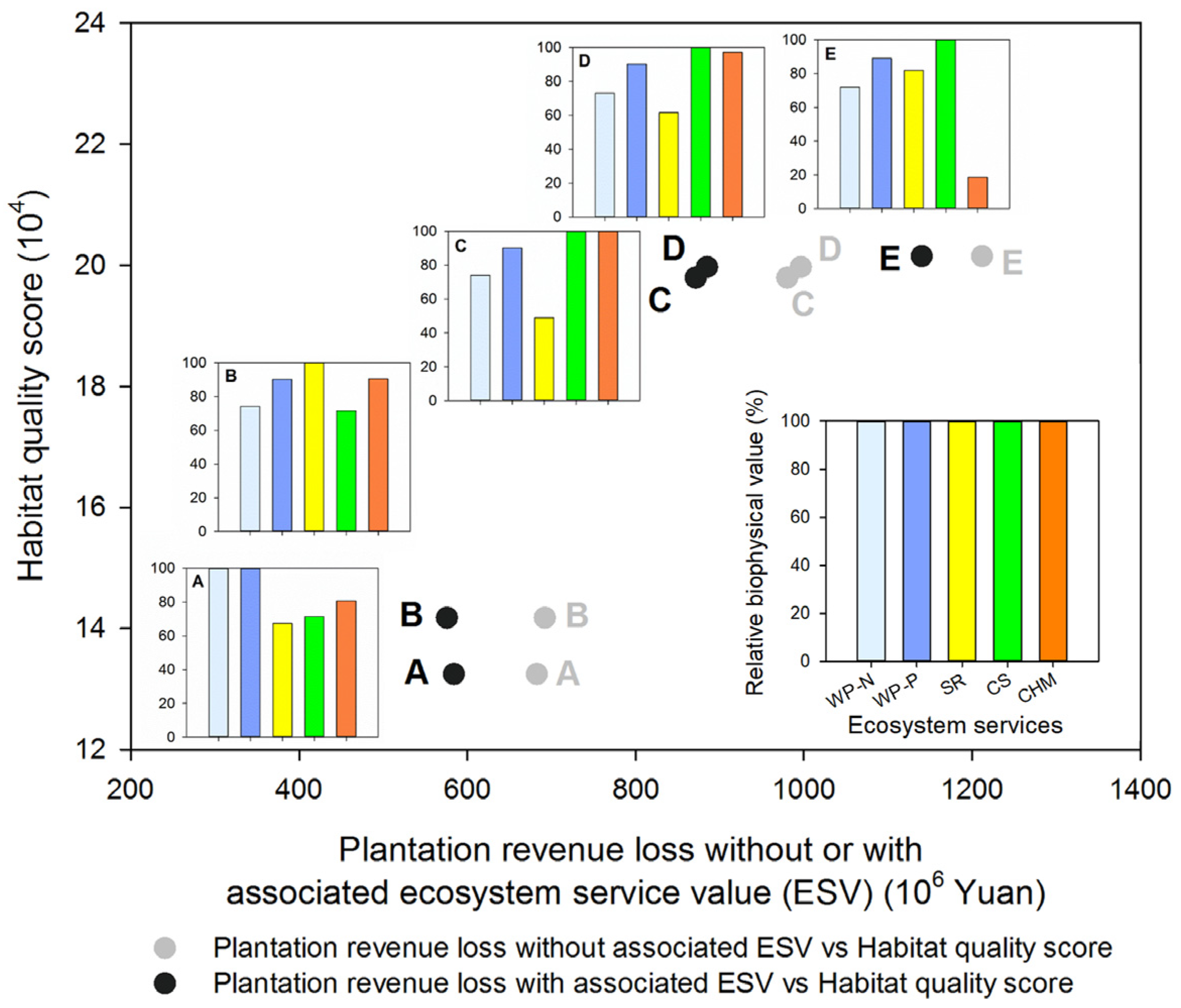Quantifying Ecosystem Service Trade-Offs to Inform Spatial Identification of Forest Restoration
Abstract
:1. Introduction
2. Materials and Methods
2.1. Study Area
2.2. Identifying Potential Areas for Forest Restoration
2.3. Assessing Ecosystem Services
2.3.1. Plantation Revenue
2.3.2. Habitat Quality
2.3.3. Water Purification
Biophysical Value
Monetary Value
2.3.4. Soil Retention
Biophysical value
Monetary Value
2.3.5. Carbon Sequestration
Biophysical Value
Monetary Value
2.3.6. Coastal Hazard Mitigation
Biophysical Value
Monetary Value
2.4. Prioritizing Spatial Location for Restoration and Identifying Trade-Off Relationships
3. Results
3.1. Trade-Off between Habitat Quality and Plantation Revenue
3.2. Spatial Configuration for Different Optimal Scenarios
3.3. Effects of Forest Restoration on other ES under Different Optimal Scenarios
4. Discussion
5. Conclusions
Author Contributions
Funding
Acknowledgments
Conflicts of Interest
References
- Scholes, R.; Montanarella, L.; Brainich, E.; Barger, N.; ten Brink, B.; Cantele, M.; Erasmus, B.; Fisher, J.; Gardner, T.; Holland, T.G. Ipbes (2018): Summary for Policymakers of the Assessment Report on Land Degradation and Restoration of the Intergovernmental Science-Policy Platform on Biodiversity and Ecosystem Servicesintensity of Aroma, Taste, Aftertaste, Mouthfeel and Colour in Tea Samples; IPBES Secretariat: Bonn, Germany, 2018. [Google Scholar]
- Bullock, J.M.; Aronson, J.; Newton, A.C.; Pywell, R.F.; Rey-Benayas, J.M. Restoration of ecosystem services and biodiversity: Conflicts and opportunities. Trends Ecol. Evol. 2011, 26, 541–549. [Google Scholar] [CrossRef] [PubMed]
- Bonn Challenge. Available online: http://www.bonnchallenge.org (accessed on 15 August 2019).
- Gourevitch, J.D.; Hawthorne, P.L.; Keeler, B.L.; Beatty, C.R.; Greve, M.; Verdone, M.A. Optimizing investments in national-scale forest landscape restoration in Uganda to maximize multiple benefits. Environ. Res. Lett. 2016, 11, 114027. [Google Scholar] [CrossRef] [Green Version]
- Yang, Z. Watershed ecology and its applications. Engineering 2018, 4, 582–583. [Google Scholar] [CrossRef]
- Sachs, J.D.; Reid, W.V. Investments toward sustainable development. Science 2006, 312, 1002. [Google Scholar] [CrossRef] [PubMed] [Green Version]
- Wang, J.; Peng, J.; Zhao, M.; Liu, Y.; Chen, Y. Significant trade-off for the impact of Grain-for-Green Programme on ecosystem services in North-western Yunnan, China. Sci. Total Environ. 2017, 574, 57–64. [Google Scholar] [CrossRef]
- Deng, X.; Li, Z.; Gibson, J. A review on trade-off analysis of ecosystem services for sustainable land-use management. J. Geogr. Sci. 2016, 26, 953–968. [Google Scholar] [CrossRef] [Green Version]
- Zheng, H.; Wang, L.; Wu, T. Coordinating ecosystem service trade-offs to achieve win–win outcomes: A review of the approaches. J. Environ. Sci. 2019, 82, 103–112. [Google Scholar] [CrossRef]
- Seppelt, R.; Lautenbach, S.; Volk, M. Identifying trade-offs between ecosystem services, land use, and biodiversity: A plea for combining scenario analysis and optimization on different spatial scales. Curr. Opin. Environ. Sustain. 2013, 5, 458–463. [Google Scholar] [CrossRef]
- Niemeyer, J.; Barros, F.S.M.; Silva, D.S.; Crouzeilles, R.; Vale, M.M. Planning forest restoration within private land holdings with conservation co-benefits at the landscape scale. Sci. Total Environ. 2019, 135262. [Google Scholar] [CrossRef]
- Pennington, D.N.; Dalzell, B.; Nelson, E.; Mulla, D.; Taff, S.; Hawthorne, P.; Polasky, S. Cost-effective land use planning: Optimizing land use and land management patterns to maximize social benefits. Ecol. Econ. 2017, 139, 75–90. [Google Scholar] [CrossRef]
- Kennedy, C.M.; Hawthorne, P.L.; Miteva, D.A.; Baumgarten, L.; Sochi, K.; Matsumoto, M.; Evans, J.S.; Polasky, S.; Hamel, P.; Vieira, E.M.; et al. Optimizing land use decision-making to sustain Brazilian agricultural profits, biodiversity and ecosystem services. Biol. Conserv. 2016, 204, 221–230. [Google Scholar] [CrossRef] [Green Version]
- Williams, K.; Biedenweg, K.; Cerveny, L. Understanding ecosystem service preferences across residential classifications near Mt. Baker Snoqualmie National Forest, Washington (USA). Forests 2017, 8, 157. [Google Scholar] [CrossRef] [Green Version]
- Borges, J.G.; Marques, S.; Garcia-Gonzalo, J.; Rahman, A.U.; Bushenkov, V.; Sottomayor, M.; Carvalho, P.O.; Nordström, E.-M. A multiple criteria approach for negotiating ecosystem services supply targets and forest owners’programs. For. Sci. 2016, 63, 49–61. [Google Scholar] [CrossRef]
- Tóth, S.F.; McDill, M.E. Finding efficient harvest schedules under three conflicting objectives. For. Sci. 2009, 55, 117–131. [Google Scholar] [CrossRef]
- Marto, M.; Reynolds, K.M.; Borges, J.G.; Bushenkov, V.A.; Marques, S. Combining decision support approaches for optimizing the selection of bundles of ecosystem services. Forests 2018, 9, 438. [Google Scholar] [CrossRef] [Green Version]
- Mansourian, S.; Stanturf, J.A.; Derkyi, M.A.A.; Engel, V.L. Forest Landscape Restoration: Increasing the positive impacts of forest restoration or simply the area under tree cover? Restor. Ecol. 2017, 25, 178–183. [Google Scholar] [CrossRef]
- Wolff, S.; Schrammeijer, E.A.; Schulp, C.J.E.; Verburg, P.H. Meeting global land restoration and protection targets: What would the world look like in 2050? Global Environ. Change 2018, 52, 259–272. [Google Scholar] [CrossRef]
- Ouyang, Z.; Zheng, H.; Xiao, Y.; Polasky, S.; Liu, J.; Xu, W.; Wang, Q.; Zhang, L.; Xiao, Y.; Rao, E.; et al. Improvements in ecosystem services from investments in natural capital. Science 2016, 352, 1455–1459. [Google Scholar] [CrossRef]
- Ouyang, Z.; Zhu, C.; Yang, G.; Xu, W.; Zheng, H.; Zhang, Y.; Xiao, Y. Gross ecosystem product: Concept framework and case study. Acta Ecol. Sin. 2013, 33, 6747–6761, (In Chinese with English abstract). [Google Scholar] [CrossRef]
- Ouyang, Z.; Song, C.; Wong, C.; Daily, G.C.; Liu, J.; Salzman, J.; Kong, L.; Zheng, H.; Li, C. China: Designing policies to enhance ecosystem services. In Green Growth That Works: Natural Capital Policy and Finance Mechanisms from Around the World; Mandle, L., Ouyang, Z., Salzman, J.E., Daily, G., Eds.; Island Press/Center for Resource Economics: Washington, DC, USA, 2019; pp. 177–194. [Google Scholar]
- O’Connell, C.S.; Carlson, K.M.; Cuadra, S.; Feeley, K.J.; Gerber, J.; West, P.C.; Polasky, S. Balancing tradeoffs: Reconciling multiple environmental goals when ecosystem services vary regionally. Environ. Res. Lett. 2018, 13, 064008. [Google Scholar] [CrossRef]
- Francisco-Ortega, J.; Wang, Z.-S.; Wang, F.-G.; Xing, F.-W.; Liu, H.; Xu, H.; Xu, W.-X.; Luo, Y.-B.; Song, X.-Q.; Gale, S.; et al. Seed plant endemism on Hainan Island: A framework for conservation actions. Bot. Rev. 2010, 76, 346–376. [Google Scholar] [CrossRef]
- Zhang, M.; Fellowes, J.R.; Jiang, X.; Wang, W.; Chan, B.P.L.; Ren, G.; Zhu, J. Degradation of tropical forest in Hainan, China, 1991–2008: Conservation implications for Hainan Gibbon (Nomascus hainanus). Biol. Conserv. 2010, 143, 1397–1404. [Google Scholar] [CrossRef]
- Lin, S.; Jiang, Y.; He, J.; Ma, G.; Xu, Y.; Jiang, H. Changes in the spatial and temporal pattern of natural forest cover on Hainan Island from the 1950s to the 2010s: Implications for natural forest conservation and management. PeerJ 2017, 5, e3320. [Google Scholar] [CrossRef] [PubMed] [Green Version]
- Li, R.; Zheng, H.; Zhang, C.; Keeler, B.; Samberg, L.H.; Li, C.; Polasky, S.; Ni, Y.; Ouyang, Z. Rural household livelihood and tree plantation dependence in the central mountainous region of Hainan Island, China: Implications for poverty alleviation. Forests 2020, 11, 248. [Google Scholar] [CrossRef] [Green Version]
- Sun, X. The Research of Compound Typhoon Prevention Strategy in Eastern Urban Belt Around Hainan Island. Ph.D. Thesis, Tianjin University, Tianjin, China, 2012. [Google Scholar]
- Zheng, H.; Wang, L.; Peng, W.; Zhang, C.; Li, C.; Robinson, B.E.; Wu, X.; Kong, L.; Li, R.; Xiao, Y.; et al. Realizing the values of natural capital for inclusive, sustainable development: Informing China’s new ecological development strategy. Proc. Natl. Acad. Sci. USA 2019, 116, 8623–8628. [Google Scholar] [CrossRef] [PubMed] [Green Version]
- NFGA. National Forest Management Plan (2016–2050). Available online: http://www.forestry.gov.cn/uploadfile/main/2016-7/file/2016-7-27-5b0861f937084243be5d17399f5f5f71.pdf (accessed on 15 December 2019).
- Wang, H.; Lu, H.; Yu, X.; Liang, H. Analysed storm surges characteristics along the coast of Hainan Island. Mar. Forecast. 1998, 15, 34–41. (In Chinese) [Google Scholar]
- Wang, L.; Zheng, H.; Wen, Z.; Liu, L.; Robinson, B.E.; Li, R.; Li, C.; Kong, L. Ecosystem service synergies/trade-offs informing the supply-demand match of ecosystem services: Framework and application. Ecosyt. Serv. 2019, 37, 100939. [Google Scholar] [CrossRef]
- Wen, Z.; Zheng, H.; Smith, J.R.; Zhao, H.; Liu, L.; Ouyang, Z. Functional diversity overrides community-weighted mean traits in linking land-use intensity to hydrological ecosystem services. Sci. Total Environ. 2019, 682, 583–590. [Google Scholar] [CrossRef]
- Aide, T.M.; Zimmerman, J.K.; Pascarella, J.B.; Rivera, L.; Marcano-Vega, H. Forest regeneration in a chronosequence of tropical abandoned pastures: Implications for restoration ecology. Restor. Ecol. 2000, 8, 328–338. [Google Scholar] [CrossRef]
- Dong, T.; Xu, W.; Zheng, H.; Xiao, Y.; Kong, L.; Ouyang, Z. A framework for regional ecological risk warning based on ecosystem service approach: A case study in Ganzi, China. Sustainability 2018, 10, 2699. [Google Scholar] [CrossRef] [Green Version]
- Wang, C.; Yang, Y.; Zhang, Y. Economic development, rural livelihoods, and ecological restoration: Evidence from China. Ambio 2011, 40, 78–87. [Google Scholar] [CrossRef] [PubMed] [Green Version]
- Sun, P.; Wu, Y.; Yang, Z.; Sivakumar, B.; Qiu, L.; Liu, S.; Cai, Y. Can the Grain-for-Green Program really ensure a low sediment load on the Chinese Loess Plateau? Engineering 2019, 5, 855–864. [Google Scholar] [CrossRef]
- Zhai, D.-L.; Xu, J.-C.; Dai, Z.-C.; Cannon, C.H.; Grumbine, R.E. Increasing tree cover while losing diverse natural forests in tropical Hainan, China. Reg. Environ. Chang. 2014, 14, 611–621. [Google Scholar] [CrossRef]
- Lin, Z.; Wu, C.; Hong, W.; Hong, T. Economic benefits analysis of carbon sequestration and timber and determination of optimal rotation period for a Cunninghamia lanceolata plantation -based on Time Series Model. Sci. Silvae Sin. 2016, 52, 134–145, (In Chinese with English abstract). [Google Scholar] [CrossRef]
- Sharp, R.; Chaplin-Kramer, R.; Wood, S.; Guerry, A.; Tallis, H.; Ricketts, T. InVEST 3.5.0 User Guide [internet]; Integrated Valuation of Ecosystem Services and Tradeoffs: Stanford, CA, USA, 2018; Available online: http://data.naturalcapitalproject.org/nightly-build/invest-users-guide/html/ (accessed on 15 August 2019).
- Terrado, M.; Sabater, S.; Chaplin-Kramer, B.; Mandle, L.; Ziv, G.; Acuña, V. Model development for the assessment of terrestrial and aquatic habitat quality in conservation planning. Sci. Total Environ. 2016, 540, 63–70. [Google Scholar] [CrossRef] [Green Version]
- Wu, J. Ecological Comprehensive Evaluation of Bamenwan Bay in Hainan Based on CA-Markov and Invest Model. Master’s Thesis, Hainan University, Haikou, China, 2012. [Google Scholar]
- Zhang, X.-F.; Zheng-Wen, L.; Yi-Fa, X.; Chen, G.-R. Evaluation on the changes of ecosystem service of urban lakes during the degradation process: A case study of Xiannǜ Lake in Zhaoqing, Guangdong Province. Acta Ecol. Sin. 2007, 27, 2349–2354, (In Chinese with English abstract). [Google Scholar]
- Ouyang, Z.; Zhao, T.; Zhao, J.; Xiao, H.; Wang, X. Ecological regulation services of Hainan Island ecosystem and their valuation. Chin. J. Appl. Ecol. 2004, 15, 1395–1402, (In Chinese with English abstract). [Google Scholar] [CrossRef]
- Yang, M.; Yi, X.; Zhiyun, O.; Hong, Y.; Maotao, D.; Ai, L. Ecosystem regulation services accounting of gross ecosystem product (GEP) in Sichuan Province. J. Southwest Minzu Univ. (Nat. Sci. Ed.) 2019, 45. [Google Scholar] [CrossRef]
- Medeiros, R.; Young, C.E.F. Contribuição das unidades de conservação brasileiras para a economia nacional: Relatório Final. Brasília: UNEP-WCMC 2011, 120, 78–94. [Google Scholar]
- Arkema, K.K.; Guannel, G.; Verutes, G.; Wood, S.A.; Guerry, A.; Ruckelshaus, M.; Kareiva, P.; Lacayo, M.; Silver, J.M. Coastal habitats shield people and property from sea-level rise and storms. Nat. Clim. Chang. 2013, 3, 913–918. [Google Scholar] [CrossRef]
- Hu, X.; Wen, C. The study of coastal protection forest in Hainan Province. Prot. For. Sci. Tech. 2009, 63–64, 93. (In Chinese) [Google Scholar]
- Zhang, Y.; Ruckelshaus, M.; Arkema, K.K.; Han, B.; Lu, F.; Zheng, H.; Ouyang, Z. Synthetic vulnerability assessment to inform climate-change adaptation along an urbanized coast of Shenzhen, China. J. Environ. Manag. 2020, 255, 109915. [Google Scholar] [CrossRef] [PubMed]
- Li, Y. Quantitative on Comprehensive Benefit of Guandong Coastal Shelterbelt and Implementation Research. Ph.D. Thesis, Beijing Forestry University, Beijing, China, 2010. [Google Scholar]
- Hawthorne, P.L.; Beatty, C.R.; Vogl, A.L. Available online: https://naturalcapitalproject.stanford.edu/root/ (accessed on 15 December 2019).
- Polasky, S.; Nelson, E.; Camm, J.; Csuti, B.; Fackler, P.; Lonsdorf, E.; Montgomery, C.; White, D.; Arthur, J.; Garber-Yonts, B.; et al. Where to put things? Spatial land management to sustain biodiversity and economic returns. Biol. Conserv. 2008, 141, 1505–1524. [Google Scholar] [CrossRef] [Green Version]
- Verhagen, W.; van der Zanden, E.H.; Strauch, M.; van Teeffelen, A.J.A.; Verburg, P.H. Optimizing the allocation of agri-environment measures to navigate the trade-offs between ecosystem services, biodiversity and agricultural production. Environ. Sci. Policy 2018, 84, 186–196. [Google Scholar] [CrossRef]
- Benz, J.P.; Chen, S.; Dang, S.; Dieter, M.; Labelle, E.R.; Liu, G.; Hou, L.; Mosandl, R.M.; Pretzsch, H.; Pukall, K.; et al. Multifunctionality of forests: A white paper on challenges and opportunities in China and Germany. Forests 2020, 11, 266. [Google Scholar] [CrossRef] [Green Version]
- Fischer, J.; Abson, D.J.; Butsic, V.; Chappell, M.J.; Ekroos, J.; Hanspach, J.; Kuemmerle, T.; Smith, H.G.; von Wehrden, H. Land sparing versus land sharing: Moving forward. Conserv. Lett. 2014, 7, 149–157. [Google Scholar] [CrossRef] [Green Version]
- Hou, L. Creating smart waterworks to produce healthy drinking water. Engineering 2019, 5, 826–827. [Google Scholar] [CrossRef]
- Redhead, J.W.; May, L.; Oliver, T.H.; Hamel, P.; Sharp, R.; Bullock, J.M. National scale evaluation of the InVEST nutrient retention model in the United Kingdom. Sci. Total Environ. 2018, 610–611, 666–677. [Google Scholar] [CrossRef]
- Li, R.; Zheng, H.; Polasky, S.; Hawthorne, P.L.; O’Connor, P.; Wang, L.; Li, R.; Xiao, Y.; Wu, T.; Ouyang, Z. Ecosystem restoration on Hainan Island: Can we optimize for enhancing regulating services and poverty alleviation? Environ. Res. Lett. 2020. [Google Scholar] [CrossRef]



| Threat | Maximum Distance of Effect (km) | Weight [0,1] | Distance-Decay Function |
|---|---|---|---|
| Garden land | 1 | 0.5 | Linear |
| Rubber plantation | 1 | 0.5 | Linear |
| Cropland | 0.5 | 0.5 | Linear |
| Urban | 2 | 0.7 | Linear |
| Roads | 1 | 1 | Exponential |
| Habitat Type | HABITAT [0,1] | Relative Sensitivity of Habitat Types to Threats | ||||
|---|---|---|---|---|---|---|
| Garden Land | Rubber Plantation | Cropland | Urban | Roads | ||
| Natural forest | 1 | 0.8 | 0.8 | 0.8 | 0.9 | 0.9 |
| Garden land | 0.5 | 0.1 | 0.1 | 0.1 | 0.8 | 0.8 |
| Rubber plantation | 0.7 | 0.1 | 0.1 | 0.1 | 0.5 | 0.2 |
| Grassland | 0.5 | 0.3 | 0.3 | 0.3 | 0.3 | 0.6 |
| Cropland | 0.5 | 0 | 0 | 0 | 0.4 | 0.2 |
| Water body | 0.8 | 0.9 | 0.9 | 0.8 | 0.9 | 0.8 |
| LULC Types | Nutrient Loading (kg ha−1 year−1) | Maximum Retention Efficiency [0,1] | Maximum Retaining Capacity of Nutrient (m) | Proportion of Dissolved Nutrients [0,1] | |
|---|---|---|---|---|---|
| N | P | N and P | N and P | N and P | |
| Natural forest | 3 | 0.15 | 0.8 | 300 | 0.5 |
| Garden land | 10.21 | 3.1 | 0.45 | 30 | 0 |
| Rubber plantation | 79.05 | 2.85 | 0.35 | 30 | 0 |
| Grassland | 7 | 0.9 | 0.4 | 150 | 0 |
| Cropland | 53.5 | 2.9 | 0.25 | 30 | 0 |
| Water body | 15 | 0.36 | 0.05 | 15 | 0 |
| Urban | 13.8 | 1.8 | 0.05 | 15 | 0 |
| Bare land | 0.88 | 0.01 | 0.05 | 10 | 0 |
| LULC Types | Cover-Management Factor [0,1] | Practice Factor [0,1] | Vegetation [0/1] | Carbon Sequestration Rate (t ha−1 year−1) |
|---|---|---|---|---|
| Natural forest | 0.003 | 1 | 1 | 7.1 |
| Garden land | 0.06 | 1 | 1 | 3.1 |
| Rubber plantation | 0.06 | 1 | 1 | 4.53 |
| Grassland | 0.015 | 1 | 1 | 0.74 |
| Cropland | 0.04 | 0.15 | 1 | 0.5 |
| Water body | 0.001 | 1 | 0 | 0 |
| Urban | 0.001 | 1 | 0 | 0 |
| Bare land | 0.2 | 1 | 0 | 0 |
| Water Purification (N) | Water Purification (P) | Soil Retention | Carbon Sequestration | Coastal Hazard Mitigation | SUM | ||||||
|---|---|---|---|---|---|---|---|---|---|---|---|
| 106 kg | 106 CNY | 106 kg | 106 CNY | 106 t | 106 CNY | 106 t | 106 CNY | Km * | 106 CNY | 106 CNY | |
| A | 3.0 | 4.5 | 0.15 | 0.38 | 2.0 | 30 | 0.10 | 12 | 23 | 52 | 99 |
| B | 2.2 | 3.3 | 0.13 | 0.33 | 2.9 | 44 | 0.10 | 12 | 26 | 57 | 116 |
| C | 2.2 | 3.3 | 0.13 | 0.33 | 1.4 | 22 | 0.14 | 17 | 29 | 67 | 109 |
| D | 2.2 | 3.3 | 0.13 | 0.33 | 1.8 | 27 | 0.14 | 17 | 28 | 64 | 112 |
| E | 2.2 | 3.3 | 0.13 | 0.33 | 2.4 | 36 | 0.14 | 17 | 5 | 15 | 72 |
© 2020 by the authors. Licensee MDPI, Basel, Switzerland. This article is an open access article distributed under the terms and conditions of the Creative Commons Attribution (CC BY) license (http://creativecommons.org/licenses/by/4.0/).
Share and Cite
Li, R.; Li, R.; Zheng, H.; Yang, Y.; Ouyang, Z. Quantifying Ecosystem Service Trade-Offs to Inform Spatial Identification of Forest Restoration. Forests 2020, 11, 563. https://doi.org/10.3390/f11050563
Li R, Li R, Zheng H, Yang Y, Ouyang Z. Quantifying Ecosystem Service Trade-Offs to Inform Spatial Identification of Forest Restoration. Forests. 2020; 11(5):563. https://doi.org/10.3390/f11050563
Chicago/Turabian StyleLi, Ruida, Ruonan Li, Hua Zheng, Yanzheng Yang, and Zhiyun Ouyang. 2020. "Quantifying Ecosystem Service Trade-Offs to Inform Spatial Identification of Forest Restoration" Forests 11, no. 5: 563. https://doi.org/10.3390/f11050563





